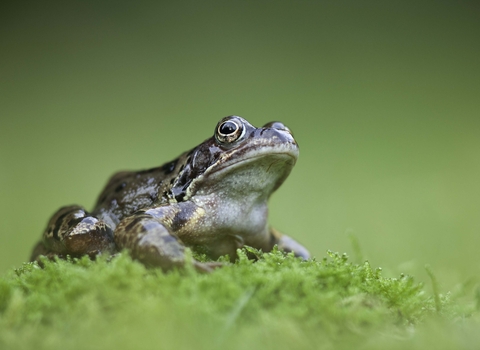
©Guy Edwardes/2020VISION
Common frog
Our most well-known amphibian, the common frog is a regular visitor to garden ponds across the country, where they feast on slugs and snails. In winter, they hibernate in pond mud or under log piles.
Scientific name
Rana temporariaWhen to see
February to OctoberSpecies information
Category
Statistics
Length: 8-13cmWeight: 22g
Average lifespan: 5-10 years
Common. Protected in the UK under the Wildlife and Countryside Act, 1981
About
Common frogs are amphibians, breeding in ponds during the spring and spending much of the rest of the year feeding in woodland, gardens, hedgerows and tussocky grassland. They are familiar inhabitants of garden ponds, where they lay their eggs in big 'rafts' of spawn. They feed on a variety of invertebrates and even smaller amphibians.How to identify
The common frog varies in colour enormously, from green to brown and even red or yellow. It has smooth skin, a dark 'mask' behind the eye and long back legs, covered in dark bands. It hops and jumps rather than walks, and lays spawn in large jelly-like clumps.Distribution
Found throughout the country, except for some Scottish islands, some of the Isles of Scilly and the Channel Islands.Did you know?
Male common frogs have 'nuptial pads' on their front feet to help them grip on to females during the breeding season. The male frog will wrap itself around the female and fertilise her eggs as they are produced; a female frog may lay up to 4,000 eggs in one spring! Frogs can spawn as early as December or as late as April depending on the weather. After hatching, tadpoles take about 14 weeks to metamorphose into froglets.Watch
Common frog (https://vimeo.com/646957976)
Russell Savory
